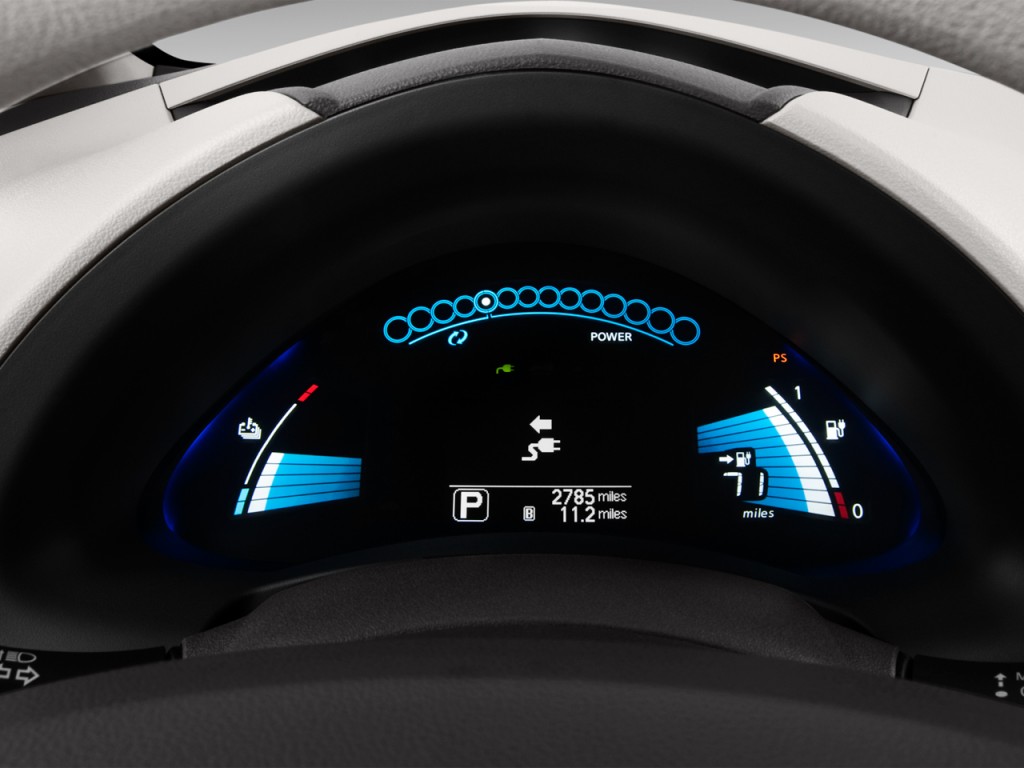It had to happen some time, just not perhaps as quickly as this.
Since Nissan’s all-electric Leaf hatchback launched in late 2010, many have been watching with interest to see how long it would be before the car’s 24 kilowatt-hour battery pack showed the gradual reduction in range and battery capacity brought about by battery aging.
Now, within a week of one another, two Nissan Leaf owners in Phoenix, Arizona have reported their cars have officially lost one of twelve high-voltage battery status bars, indicating a substantial loss in original battery capacity.
Thus far, we suggest Leaf owners not worry--and that they rigorously follow Nissan's charging instructions, which it's not clear the two owners who lost that first bar did.
Battery capacity
But what does losing that first capacity bar mean? And should you worry?
Just like any other lithium-ion battery, the battery pack in the Nissan Leaf exhibits a drop in battery capacity over time.
In other words, the amount of energy it can store gradually reduces over time.
In gadgets like cellphones and laptop computers, that equates to a shorter operational time before recharging is required. In an electric car, battery capacity loss equates to a shorter range.
2012 Nissan Leaf 4-door HB SL Instrument Cluster
Twelve lights
To enable owners to keep track of their Leaf’s battery health, Nissan designed the Leaf with two different bar graphs clustered in the same state-of-charge display.
The longer bars on the left of the state-of-charge display indicate current battery charge -- or how full the car is. The smaller, set of bars on the right indicate the battery’s overall capacity over time.
As its battery ages, the right-side gauge slowly falls, with the first light extinguishing when 15 percent of the battery’s original capacity has been lost.
Two cars, both in AZ
So far, the only two Nissan Leaf’s we’ve heard of that have lost their first capacity light are in Phoenix Arizona. One lost its first capacity bar after 17,000 miles and 14 months, while another owner reported losing their first capacity bar at 13,633 miles and one year.

A Day In The Life Of A Nissan Leaf
In both cases, the owners report charging their Leafs to 100 percent full every night, using a level 2 charging station.
High temperature, poor charging practice?
With daytime temperatures reaching in excess of 100 degrees Fahrenheit, and nighttime temperatures rarely going below 70 degrees, some Leaf fans are speculating that the extreme heat of Arizona is prematurely aging the battery packs.
But we suspect the charging practice has more effect than the heat.
The first owner to report a problem, with a 15 percent loss in battery capacity after 17,000 miles and 14 months, admitted that her car sat for nearly a month during May 2011 with a full battery pack.
This is considered bad practice, since leaving a battery fully charged for an extended length of time is known to prematurely age the battery.
Secondly, the owner reports that the Leaf in question is regularly recharged to 100 percent, even when its battery pack is more than 98 percent full "topped off", recharging the battery back to full when it is more than half full. This is also known to prematurely age lithium ion battery packs.
As a point of note, Nissan advises against both of the above, which could invalidate the car’s battery warranty if frequently carried out.
2011 Nissan Leaf: One Year Drive Report
Low battery, rapid charging not an issue
Interestingly, both of the cars which have so far experienced a drop in capacity are not regularly taken to a low state of charge.
Neither have the owners in question made frequent use of rapid charging stations, with one never using the facility and one reporting only two or three rapid charges during their car’s life.
Should you worry?
As Mark Perry, Nissan North America’s director for product planning and advanced technology has previously indicated, it is expected that the battery packs in the 2011 and 2012 Nissan Leafs will retain 70 to 80 percent of their original capacity after 10 years.
That’s far slower than the two reported cases of battery capacity loss would suggest, but we don’t think there’s cause for concern just yet.
With nearly 12,000 Nissan Leafs now on the road in the U.S., and tens of thousands on the road around the world, these are the only two cases we’ve seen of premature battery capacity loss.

2011 NIssan Leaf Battery Warranty Information
Moreover, with many Leafs now well past one year old, most Leaf drivers are reporting the same performance and range as they did when new.
Our own Leaf, purchased in March 2011 and now with nearly 17,000 miles on the odometer, hasn’t yet suffered any noticeable reduction in capacity or range capabilities, while one Leaf has traveled 36,000 miles in 11 months without battery woes.
In short, it appears both cases are rare exceptions to the rule, rather than rule-setters.
Our advice?
At the moment, with only two cases, it’s too early to claim that ALL Nissan Leafs will suffer rapid battery degradation in such a short period of time.
Of course, we’ll keep track of the situation as it develops, but for now, we advise all Leaf owners to be mindful of their car’s battery, ensuring that it is charged and used in accordance with Nissan’s own battery care advice.
[EDIT:: At the request of one of the Leaf owners in question, we have been requested to change the definition of "topping off". Our original text now appears in strike-thru text, and we apologize for any misunderstanding the original text may have caused.]
+++++++++++













